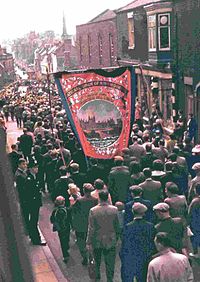- Durham Miners' Gala
-
The Durham Miners' Gala is a large annual gathering held on the second Saturday in July in the city of Durham, England.[1] It is associated with the coal mining heritage (and particularly that of miners' trade unionism) of the Durham Coalfield, which stretched throughout the traditional County of Durham. It is also locally called "The Big Meeting" or "Durham Big Meeting". In the context of the Durham Miners' Gala, "gala" is usually pronounced "gayla" rather than the more common pronunciation "garla". [2][3]
Its highlight consists of banners, each typically accompanied by a brass band, which are marched to the old Racecourse, where political speeches are delivered. In the afternoon a Miners' service is held in Durham Cathedral which may include the blessing of any new banners.
Contents
History - out of unionism
 Easington Lodge banner at the 1976 Gala. It is draped in black to commemorate 25 years since the Easington Colliery disaster of 1951, which killed 85.
Easington Lodge banner at the 1976 Gala. It is draped in black to commemorate 25 years since the Easington Colliery disaster of 1951, which killed 85.
The gala developed out of the miners' trade unionism, with the first Union being established in 1869.[4] The Durham Miners' Association organised the first Gala, which was held in 1871 in Wharton Park, Durham.
It developed into the largest unofficial miners and trade union gathering in the United Kingdom. At its peak the Gala attracted over 300,000 people[5] - over 7 times the population of Durham city itself.
Banners would traditionally be taken on foot from its particular colliery into Durham, and the event was marked by large unions of men marching on the roads leading into the city.
The socialist, and often communist, nature of the miners' unionism found expression in the Gala. In particular, the banners contain several images of notable socialist/communist figures, and captions capture similar sentiments.
The Gala was cancelled from 1915-18 (due to the First World War), 1921, 1922, and 1926 (all due to strikes), and again from 1940-45 due to the Second World War.[6] The effect of the 1984-85 miners' strike, which saw miners across the Durham Coalfield strike, also led to the Gala being called off in 1984.[6]
The closure of collieries in County Durham, particularly after the Second World War, reduced the numbers attending the Gala. Nonetheless, even if a colliery was closed, the banner was often still marched.
The centenary Gala was held in 1983.
The banners
Most banners represent lodges of the National Union of Mineworkers in the Durham Area. However, other unions have also been represented, particularly in recent years, as well as Union banners from other parts of the UK, including NUM lodges of the Yorkshire branch, and South Wales.
They are made of silk, are rectangular, and hang from a cross member, from which guide ropes are held by those carrying it.[7] Traditionally banners were draped in black cloth when there had been a death in the pit during the previous year. More recently following the closure of pits across the county they are draped with black cloth on significant anniversaries of disasters at the colliery they represent.
Many banners contain explicit socialist or communist references, having renderings of Marx, Lenin, and other prominent figures such as miners' leaders, or politicians. Chopwell, often referred to as "Little Moscow",[8] has the only banner (the 1955 version) that contains images of both Marx and Lenin (as well as the hammer and sickle). The 1935 Chopwell banner toured the Soviet Union and is thought to reside somewhere in Moscow today.[8] Socialist expressions also take the form of captions - for example, "Socialism through evolution" and "Need before greed" (on Blackhall Lodge's banner).
Christian themes having a socialist resonance also figure on some banners.[7]
More recently, residents in former pit villages have taken it upon themselves to restore, or even create, banners. This has involved the reintegration of collieries that had left the Gala. Some banners, such as Spennymoor's, represent a group of former local collieries rather than individual ones. These have received funding from the Heritage Lottery Fund.[9]
Gala today
No deep mines remain in the Durham Coalfield, down from the over hundred that were present at the coalfield's peak. Despite this, the Gala continues to be organised.
The 122nd Gala, held in 2006, attracted over 50,000 people, and approximately 100,000 attended in 2009,[10] making it one of the biggest political gatherings in Europe. During the morning banners are still marched to the racecourse with its tradition of speeches (recent notable speakers have included Tony Benn, Billy Bragg and Ken Livingstone) then in the afternoon to the cathedral. [11]
References
- ^ Durham Miners Gala 2010 BBC.co.uk
- ^ http://news.bbc.co.uk/local/wear/hi/people_and_places/history/newsid_8800000/8800605.stm
- ^ http://www.answers.com/topic/gala
- ^ Your View 22 - Moving on seamlessly
- ^ /http://news.bbc.co.uk/1/hi/england/5160580.stm
- ^ a b "Durham Mining Museum: Durham Miners' Gala". http://www.dmm.org.uk/history/gala.htm. Retrieved 2009-05-04.
- ^ a b Durham Miner Project - Banners of Durham Miners' Union 1869 to the present
- ^ a b Roy Lambeth's Durham Miners Gala Banner Photographs. 1983
- ^ Durham Miners Gala - Heritage Lottery Fund
- ^ Durham Miners' Gala 2009 BBC.co.uk
- ^ "Sermon: Miners' Festival". 2007-07-14. http://www.durhamcathedral.co.uk/schedule/sermons/168. Retrieved 2008-05-31.
Further reading
- Fynes, Richard (1873). The Miners of Northumberland and Durham. Blyth: John Robinson, Jun.. http://books.google.com/?id=qYIHAAAAQAAJ. Retrieved 2008-02-28
External links
- Durham Mining Museum
- Photographs of 1970s Miner's Banners by Peter Loud
Videos
- Spennymoor banner in 2006
- Bowburn banner in 2007
- A slideshow tribute to the colleries of County Durham, including Dawdon, Murton, Seaham and Sunderland pits: [1]
- Durham Miners' Gala 2009
- NASUWT banner in 2010
- Durham Miners' Gala July 2011
Categories:- County Durham
- Economy of County Durham
- British trade unions history
- Miners' labor movement
- Mining in England
- Mining in County Durham
- National Union of Mineworkers (UK)
Wikimedia Foundation. 2010.

